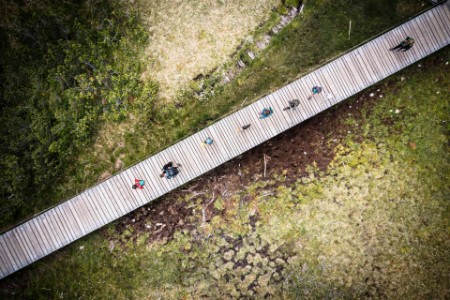
Chapter 1
Engage a bold, positive vision of the future
Regeneration reframes the narrative around a positive vision.
Communications and messaging related to sustainability — especially climate change — focus on impending catastrophe, deal in scientific scenarios based on degrees of global warming, and look to milestones years ahead. Nearly perfectly designed to run up against human psychology, in other words.
Human behavior suffers from optimism bias, the tendency to overestimate the likelihood of experiencing positive events and underestimate the likelihood of experiencing negative events. We value smaller rewards and costs in the present substantially more than larger ones in the future. Moreover, we struggle to believe things that are not easily and vividly imagined. People have a hard time envisioning climate having an impact on their lives anytime soon.
We tend to freeze when confronted with bad things but are more likely to act for rewards. If you highlight the positive end result, people are more likely to engage.
Instead, they avoid considering climate at all. “We tend to want to look away from something negative because it elicits negative feelings,” says Dr. Tali Sharot, Director of the Affective Brain Lab at the University College of London. “We tend to freeze when confronted with bad things but are more likely to act for rewards. If you highlight the positive end result, people are more likely to engage.”
Regeneration reframes the narrative around a positive vision. “A much bolder vision that says, actually, we're going to set out to make it better from the get-go, and not sell ourselves and the planet short, is a really powerful narrative,” explains Miguel Veiga-Pestana, former Head of Corporate Affairs and Chief Sustainability Officer at Reckitt. “Changing how people and companies behave will depend on mobilizing them behind this vision.”
Education will be key. So will connecting and organizing the people already engaged with the idea of regeneration. “Connecting them both locally and globally will create the needed leverage, and bring this movement to a tipping point,” says Éliane Ubalijoro, Executive Director of Sustainability in the Digital Age and the Global Hub Director in Canada for Future Earth.

Chapter 2
Scale and co-create regenerative innovation
Natural and technology solutions abound; establishing collaborative and reciprocal relationships is key.
Dimensions of a regenerative future are being manifested in different places and ways around the world. Impact entrepreneurs, B-corps, startups and other innovators represent a deep pool of innovation which enable regenerative outcomes. Whether nature-based approaches, new technologies or new forms of collaboration, accessing and scaling this innovation can help large corporations go further, faster in sustainability. Discussed below are some of the key opportunities for engaging with regenerative innovation.
Begin with nature
As humans’ largest incursion into natural ecosystems, and the foundation of our food systems, agriculture is one of the primary opportunities for regeneration. Patagonia recently began shifting its business model away from apparel to food, given the greater opportunity to make a net-positive contribution through regenerative agriculture.
For many farmers, the regenerative farming practices that restore soil health and increase carbon sequestration are a welcome return to more traditional ways. A number of organizations have sprung up to accelerate the shift to regenerative agriculture by creating ways to monetize its environmental benefits on behalf of farmers, such as generating carbon credits based on improvements in soil sequestration.
Listen to Rob Dongoski, EY Agribusiness Leader, speaking at Innovation Realized 2022 on the key question for agriculture.
Regenerative agriculture is also becoming a front end to bioeconomy applications that use organic inputs, such as biomaterials and biochemicals, because the practice deepens the carbon benefits and broadens the sustainability impact to agricultural communities.
Leverage enabling technologies
Several technology areas are emerging as key enablers of a regenerative economy. These technologies help to replace fossil fuels as a production input, eliminate carbon emissions, drive circularity, and produce nature-based solutions. Still, technologies are not inherently regenerative; they must be part of broader systems change. There is no panacea.
But there are important catalysts. “Incredible founders and talent are moving into our space,” says Dan Fishman, General Partner of Regeneration.VC, a venture capital firm building a portfolio of companies applying circular and regenerative principles to innovate consumer markets. “They’re leaving jobs at top-tier tech companies to find solutions to our planet’s environmental crises. It’s fundamental to their ethos, not marketing. Corporate commitments, companies recognizing extended producer responsibility, and international regulatory momentum, give them a place to scale their businesses.”
Tap into synthetic biology and the microbiome
Microorganisms, such as bacteria, fungi and algae, play essential roles in living systems. All visible life depends on their microscopic biochemical abilities to turn one substance into another. Supercharging these abilities through synthetic biology could be a key enabler for regeneration by:
- Replacing petroleum and animal inputs with agriculture-based inputs in industrial and consumer products
- Enabling plastic bio-recycling and carbon removals from industrial emissions
- Improving soil carbon and crop resilience, and reducing fertilizer inputs
Remove carbon
Nature-based and engineered carbon removal approaches are proliferating, from forest projects and large-scale direct-air-capture installations to modular capture units, carbon-sequestering materials and consumer products. Carbon removal lays the groundwork for the long-term regeneration of the atmosphere after the main levers of decarbonization — renewables, efficiency and electrification — have been fully realized. It also creates the opportunity for:
- New income opportunities for farmers and forest communities, as well as biodiversity benefits
- Converting carbon from a waste product to a circular resource
- Scaling carbon-negative products, such as building materials and consumer products, to drive decarbonization
Employ earth imaging and remote sensing
The unprecedented powers of earth imaging and remote sensing of physical characteristics provided by a growing fleet of satellites is revealing deep planetary insights which will be critical to achieving regenerative outcomes. Satellites are giving us unprecedented abilities to comprehend both the system and the parts, the forest and the tree. One indication of the strength of this trend: there are currently nearly 300 private companies focused on satellite imaging and remote sensing in venture capital portfolios, which have raised $4b in venture financing to date.6 These venture-backed companies are exploring various applications, including:
- Improving and verifying the performance of nature-based carbon removals
- Real-time monitoring and prediction of greenhouse gas emissions, deforestation and illegal fishing
- New insights into climate change, biodiversity, land use, water and natural resource extraction
Engage now with Web 3.0 and the metaverse
Social innovators are utilizing the tools of Web 3.0 — blockchains, tokenization, coins and more — with the aim of building regenerative organizations, both in their operations and their purposes. They’re launching impact decentralized autonomous organizations (DAOs) to create public goods and generate positive externalities without relying on incumbent systems. DAOs are organizations owned and democratically governed by a community in which operations are controlled by blockchain-based smart contracts.
Impact DAOs are being designed to embody the regenerative values of collaboration, co-creation, and empowered participation. Many are focused on catalyzing financing for nature-based carbon removals while creating positive impacts for the communities hosting them.
The convergence of AI, AR/VR, and IoT and satellite-generated data in the metaverse promises to enable regeneration through digital twins, which will model earth systems with new scope and detail. The European Space Agency is working toward a digital twin of the entire earth. This convergence of digital and physical will open possibilities for visualizing and forecasting the impacts of human activity on natural systems, and for simulating environmental scenarios to inform policy decisions.
Combine for end-to-end impact
Regenerative approaches and enabling technologies can be combined for end-to-end impact. Gevo, a company working to create net-zero (and ultimately carbon net-negative) sustainable aviation fuels provides an example. The company is systemically addressing carbon performance across its entire supply chain and products.
Gevo’s feedstocks are grown using regenerative agriculture practices to enhance soil carbon sequestration and minimize the use of synthetic fertilizers and other sources of field-level emissions. It is also trialing microbiome-based soil enhancements to further improve soil carbon retention.
Renewable energy powers biofuel production, and the company’s innovations in synthetic biology have yielded yeasts that convert agricultural feedstocks into isobutanol and ethanol more efficiently.
To measure and verify the climate performance of its supply chain and fuels, the company, along with Blocksize Capital, is developing Verity Tracking, a blockchain-based measurement, reporting and verification system for full carbon lifecycle product differentiation and tracking, from farm through to jet engines, and even to the aircraft’s seat.
“Demonstrating the end-to-end impact of regenerative approaches and systemic decarbonization is essential for these investments to be recognized and appropriately valued by customers and other stakeholders,” says Jason Libersky, Chief Product Officer of Verity Tracking.
Co-create with new ecosystem relationships
It would be impossible for a company to achieve regenerative outcomes in isolation. Regeneration requires moving a system in its entirety, which in turn demands establishing collaborative and reciprocal relationships within it. “Inherent in the regenerative concept is thinking larger than yourself. For it to work, you have to be prepared to give something to get something,” says Lisa Lindström, EY Global Innovation and Experience Design Leader.
“In a business sense it means that everything has two functions — to take and give back,” notes Stephanie McEvoy, Founder, Farming Carbon. “It's reciprocal. In terms of supply chain, procurement, consumer and community relationships, it’s important that we move away from an extractive mindset.”
At its most fundamental, it’s identifying a system (e.g., food, water, energy), a place where the system is uniquely manifested, and the capabilities and resources which can offered. While ecosystem partners could come from another sector or even a competitor, realizing regenerative outcomes will require engaging with a broader set of local stakeholders more deeply in co-creation than many large companies are used to.
For big companies, ensuring empowered participation in the ecosystem, along with careful consideration of who benefits, who is included, and who has a voice, will be essential and likely require developing new skill sets.
Inherent in the regenerative concept is thinking larger than yourself. For it to work, you have to be prepared to give something to get something.
Yet, large companies are not necessarily in the driver’s seat. Small, active and impassioned businesses can influence larger corporations to help bring regenerative practices to scale. Innovative companies like the brewer Toast Ale, which led a regenerative agriculture collaboration involving two dozen other breweries and global brands, bring the industry along with them by demonstrating the potential of new approaches.
In the recent EY Sustainable Value Study, we found that companies leading on climate action take a more holistic and collaborative approach. They capture more financial value and have reduced emissions more to-date as a result.
EY Sustainable Value Study 2022
96%Of companies leading on climate change have established or are in-progress of creating partnerships to address climate change.
EY Sustainable Value Study 2022
57%Of companies leading on climate change have already partnered with a direct competitor.
Regenerative innovators are looking for corporates who share their action-oriented and systems-changing mindset. “There are business leaders in companies asking: What can we do today? How can we take the innovation and thinking across sector, across industries, and make some of the biggest transformative projects happen? That’s also what I’m after,” says Florent Kaiser, CEO of Global Forest Generation.
Ecosystem orchestration to unlock the circular economy
Achieving resource circularity is essential to solving the problems of waste, greenhouse gas emissions, and resource overconsumption, and ultimately creating an opportunity for regeneration. However, circularity brings unique business challenges. “You need a gravitational mass to create circularity,” says Greg Sarafin, Global Managing Partner — EY Alliance Ecosystem, “large companies that can bring the necessary ecosystem players into their orbits, which creates the commercial basis for regenerative trade flows.”
The companies with the necessary mass and imperative to act most aggressively are the consumer products and energy companies sitting at the nexus of resource-intensive value chains. As they seek to influence consumer behavior, packaging, product reuse, energy consumption and decarbonization, “these companies are realizing they need to pivot from participating in linear value chains to actively orchestrating regenerative ecosystems. Several large companies have already created new BUs to start on this journey,” he says.
The challenge will be to develop the commercial agility to operate the business in the dynamic context of the ecosystem. This will likely demand removing the frictions of human interventions. “We’ll need commercial models which are less fixed, much more dynamic, and increasingly operate on zero trust. Success will be driven by how fast an organization’s structure can decompose and recompose in new models,” Sarafin adds.

Chapter 3
Measure value differently for regenerative outcomes
We need new, holistic, long-term value measures, and fast.
The EY Megatrends 2020 and beyond report highlighted the need for new metrics of human, social and environmental well-being. This need has only become more urgent as the climate crisis, and the social and economic dislocations in the wake of the global pandemic, underscore the inadequacy of our measures of progress and well-being.
To regenerate, we need holistic, long-term measures incorporating multiple dimensions of value and wealth, including financial but also natural, social and cultural. Important dimensions include:
- Moving beyond GDP: GDP doesn’t account for market externalities, such as the environmental and social costs of production, or income and wealth distributions leading to rising inequality. It’s a reductive measure of short-term growth, not an indicator of long-term development or well-being. New Zealand’s Living Standards Framework, and other frameworks, such as the Genuine Progress Indicator, offer models of more holistic measurements focused on human development.
- Accounting for natural capital assets and ecosystem services: Understanding natural and social value creation depends in large part on accounting for natural capital assets and their value in providing ecosystems services to people. The UN’s SEEA Ecosystem Accounting framework, approved in 2021, contributes a national-level approach for defining an ecosystem asset, its condition, services provided, social benefits and beneficiaries across the economy.7
- Measuring against natural and social thresholds: As the imperative to respect planetary boundaries and achieve social foundations grows more urgent, so does the need for metrics anchored to these thresholds so that we understand whether we are increasing or decreasing system capacity and health. Measures of progress in natural resource consumption should be set in the context of overall resource availability and system sustainability. Similarly, social metrics should be tied to an identified threshold, such as the local living wage.
- Reporting on double materiality in ESG: Single materiality considers only the inward impacts of external sustainability topics on a company’s value for shareholders. Double materiality adds the company’s outward impacts on the economy, the environment, and people for the broader set of stakeholders, such as governments, consumers, employees and communities. This process will help focus regenerative efforts. The European Union’s Corporate Sustainability Reporting Directive (CSRD) centers on a double materiality approach and is expected to be influential globally.
We also need common, comparable metrics for corporate long-term value creation. WEF-IBC, a group comprised of 120 global CEOs, including our own, has taken an important step to realize this objective. The group has proposed 21 core metrics and 34 expanded metrics which enable consistent and comparable ESG disclosures across industries and geographies. The metrics support four interconnected pillars — governance, people, planet and prosperity — aligned to the UN Sustainable Development Goals. WEF-IBC metrics can help companies demonstrate progress toward purpose-driven goals and report on a broader spectrum of value in a clear and comparable way.

Chapter 4
Start your regenerative transformation journey
Regenerative transformation begins with a bold, positive vision, informed by your organization’s purpose.
As climate change and our biodeficits continue to drive growing social impacts among customers, employees, suppliers and communities, leading companies will be able to demonstrate a positive vision and impact as part of their long-term value creation strategies.
“Businesses that build regeneration in the places and communities in which they operate,” says Veiga-Pestana, “will also benefit from enhanced resilience to the stresses and disruptions — whether related to climate, resources, technology or social — which we’re experiencing with greater frequency and severity.”
A regenerative transformation requires a different mindset, one that is willing to break out of existing frames. “People are looking for community-co-created, localized, decentralized solutions, and actually that's part of both the opportunity but also the challenge for companies that are hierarchical, centralized or highly structured,” says Veiga-Pestana. “This actually is quite anarchic because it requires you to blow up all of the prevailing thinking and radically liberate.”
It also requires a new purpose, one that enmeshes the company in a new relationship with nature and stakeholders. Yet, it’s less about defining a purpose than “illuminating the purpose and culture that already exists in your organization,” says EY’s Lindstrom. “Younger generations are much more open to this. If you, as a leadership team, tune into the channels and frequencies of your younger cohorts, you’ll find you already have it.”
Businesses that build regeneration in the places and communities in which they operate will also benefit from enhanced resilience to the stresses and disruptions.
There will also need to be a dimension of regenerative self-disruption, cultivating alternative business within the organization to create a new direction from the inside. However, “there’s usually a big gap between growing a regenerative business seedling fertilized with PR and communication value into a mature tree that can outcompete the incumbent businesses,” says Tom Szaky, Founder, of TerraCycle/Loop. “One of the biggest challenges is where the existing infrastructure relates to the new business. It's important to think about what those barriers will be, because otherwise we'll just get little pilots which never achieve the strength they need to shift the system.”
A shift in values is required

A regenerative future(s)-back approach
Reframing the fundamental assumptions about the future, the way the economy works, new drivers of business value and measuring wealth and well-being across localized markets requires challenging traditional methods of business planning and thinking.
A future-back approach is designed to start with multi-generational futures about how the external world will exist and then consider your company’s role in that future; not extrapolate on current market trends, regulatory agendas and economic shifts. If you don’t start by reframing your view of the future external environment, your strategic plans will be constrained as a continuation of past models by definition.
“In times of existential shifts, like a global move to regeneration, future-back planning is the only way to establish a purpose and vision fit for the future that bridges back to the transformative actions needed today,” notes Michael Kanazawa, EY Global Innovation Realized Leader.
Most companies are at different points in their journey simultaneously, perhaps green in one dimension and moving toward neutrality in another. Charting a path to regenerative transformation begins with a bold, positive vision of the future and its value drivers. Then, informed by your purpose, define your company’s future state. Key guiding questions include:
- Working backward, what are the capabilities, business model changes and innovations needed to bridge the gaps from today?
- How and where will value be generated tomorrow? How fast and where should we self-disrupt?
- What external ecosystem of partners and other stakeholders need to be engaged in co-creation to realize systemic changes?
- Which metrics will drive regenerative outcomes?
Gaining insights and preferences across stakeholders will be critical to generate the full view of how to answer these questions from employee, customer, channel partner, investor, regulator and societal points of view. The answers will create the actionable strategies for creating and protecting value today.
Related articles
Summary
It’s difficult, if not impossible, for any company to be truly and fully regenerative today. But it’s possible — and imperative — to begin the smaller transformations which will result in a big transformation, both in the company and outside it. This is the beginning of an iterative journey of co-creation, experimentation, evaluation, execution and learning.


